MBA管理经济学
mba管理经济学试题及答案

mba管理经济学试题及答案尊敬的读者,以下是一份涵盖了MBA管理经济学试题及答案的文章,请您参考。
一、选择题1.以下哪个是管理经济学研究的对象?A.经济环境B.经济学原理C.企业经营D.资本市场2.管理经济学的核心任务是?A.提高市场竞争力B.优化资源配置C.解决企业问题D.制定经济政策3.当供给曲线发生左移时,价格和数量的变化分别是?A.价格上升,数量上升B.价格上升,数量下降C.价格下降,数量上升D.价格下降,数量下降二、简答题1.请简要解释“市场需求的弹性”。
市场需求的弹性,简言之,即指某一商品或服务需求量对价格变化的敏感度。
需求弹性可以分为价格弹性和收入弹性两种类型,用于衡量需求对于这两个因素的反应程度。
价格弹性代表需求量对价格变化的敏感程度,收入弹性则表示需求量对收入变化的敏感程度。
2.简述“边际效益递减原理”。
边际效益递减原理指的是,在经济领域中,随着某一变量的增加,其产生的边际效益将会递减。
换言之,当增加一单位的投入或变量时,最初的增益可能是显著的,但随着投入的继续增加,每一单位新增的效益将会逐渐减少。
三、计算题1.某企业的总收入为5000元,总成本为4000元,计算企业的利润和利润率。
利润 = 总收入 - 总成本 = 5000 - 4000 = 1000元利润率 = 利润 / 总收入 * 100% = 1000 / 5000 * 100% = 20%2.某产品的市场需求曲线为:Qd = 1000 - 10P,供给曲线为:Qs =2P - 200。
求市场的均衡价格和数量。
将需求曲线与供给曲线相等,得到:1000 - 10P = 2P - 200整理后可得:P = 60将P = 60代入需求曲线或供给曲线,可得市场均衡的数量为:Qd = 1000 - 10 * 60 = 400Qs = 2 * 60 - 200 = -80(舍去)因此,市场的均衡价格为60,数量为400。
以上是MBA管理经济学试题及答案的部分内容,希望对您的学习有所帮助。
管理经济学MBA

管理经济学MBA管理经济学是MBA课程中的一门重要课程,它是研究经济学原理在管理决策中的应用。
管理经济学MBA课程旨在培养学员的经济思维能力,通过分析经济环境和市场条件,帮助管理者制定有效的战略和决策方案,从而在竞争激烈的商业环境中取得成功。
课程内容管理经济学MBA课程涵盖了多个主题和概念,包括但不限于以下内容:1.需求和供给分析:学习如何运用市场分析和需求曲线来预测消费者行为和市场趋势,以便做出符合市场需求的战略决策。
2.成本与效益分析:研究企业的成本结构,了解不同决策对成本和效益的影响,以便为企业提供最佳的资源配置方案。
3.市场结构与竞争策略:研究不同市场结构下的竞争环境,探讨不同策略对企业市场份额和利润的影响,以便制定有效的竞争策略。
4.经济增长与发展:了解宏观经济因素对企业决策的影响,探讨经济增长的驱动力和经济发展的各种路径。
5.不确定性与决策风险:研究不确定性条件下的决策分析和风险管理,帮助企业在不确定的环境中做出明智的决策。
课程目标管理经济学MBA课程的目标是帮助学员:1.掌握经济学的基本概念和方法,运用经济学思维分析管理决策中的经济问题。
2.理解市场环境和市场力量对企业决策的影响,为企业提供合理的战略选择和市场定位建议。
3.学会利用经济工具和模型进行决策分析,评估不同方案的成本和效益,为企业提供最优化的决策方案。
4.能够运用经济理论和数据分析技巧解决实际管理问题,提供有针对性的决策支持和战略建议。
课程评估管理经济学MBA课程的评估方式一般包括以下几个方面:1.个人作业:通过个人作业评估学员对课程内容的理解和掌握程度。
2.小组项目:学员组成小组,完成与管理经济学相关的项目,并进行实际案例分析,以培养学员的团队合作和解决问题的能力。
3.期末考试:通过综合考核学员的知识掌握程度和分析能力。
就业前景具备管理经济学知识的MBA毕业生在就业市场上有很大的竞争优势。
他们可以在各种行业和领域中找到就业机会,包括但不限于以下职位:•战略规划师•市场分析师•风险管理师•项目经理•供应链分析师•财务顾问管理经济学MBA课程为学员提供了掌握经济学概念和方法的机会,帮助他们在管理决策中更好地理解和运用经济原理。
《管理经济学》总复习
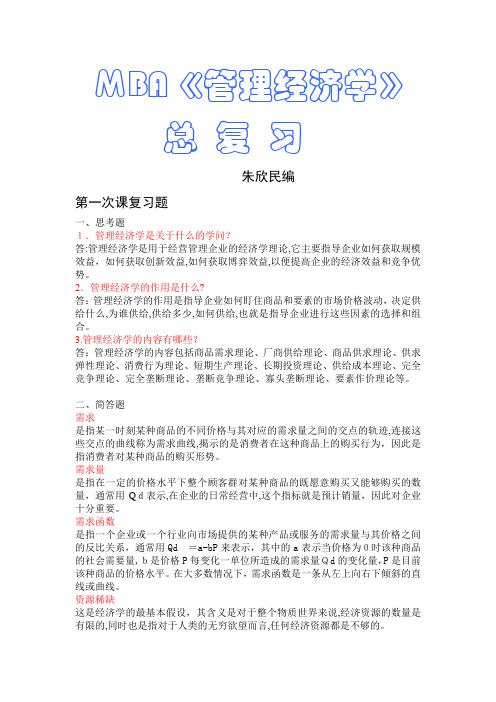
MBA《管理经济学》总复习朱欣民编第一次课复习题一、思考题1.管理经济学是关于什么的学问?答:管理经济学是用于经营管理企业的经济学理论,它主要指导企业如何获取规模效益,如何获取创新效益,如何获取博弈效益,以便提高企业的经济效益和竞争优势。
2.管理经济学的作用是什么?答:管理经济学的作用是指导企业如何盯住商品和要素的市场价格波动,决定供给什么,为谁供给,供给多少,如何供给,也就是指导企业进行这些因素的选择和组合。
3.管理经济学的内容有哪些?答:管理经济学的内容包括商品需求理论、厂商供给理论、商品供求理论、供求弹性理论、消费行为理论、短期生产理论、长期投资理论、供给成本理论、完全竞争理论、完全垄断理论、垄断竞争理论、寡头垄断理论、要素作价理论等。
二、简答题需求是指某一时刻某种商品的不同价格与其对应的需求量之间的交点的轨迹,连接这些交点的曲线称为需求曲线,揭示的是消费者在这种商品上的购买行为,因此是指消费者对某种商品的购买形势。
需求量是指在一定的价格水平下整个顾客群对某种商品的既愿意购买又能够购买的数量,通常用Qd表示,在企业的日常经营中,这个指标就是预计销量,因此对企业十分重要。
需求函数是指一个企业或一个行业向市场提供的某种产品或服务的需求量与其价格之间的反比关系,通常用Qd =a-bP来表示,其中的a表示当价格为0时该种商品的社会需要量,b是价格P每变化一单位所造成的需求量Qd的变化量,P是目前该种商品的价格水平。
在大多数情况下,需求函数是一条从左上向右下倾斜的直线或曲线。
资源稀缺这是经济学的最基本假设,其含义是对于整个物质世界来说,经济资源的数量是有限的,同时也是指对于人类的无穷欲望而言,任何经济资源都是不够的。
三项假设这是经济学得以建立的基本条件假设,包括供求双方完全理性、供求双方都能获得充分信息和供求双方交易不受任何人为或自然的约束。
三、计算题1. 某公司25英寸彩电有中国、北美和拉美三个市场,其需求函数分别为Qd1=5000-2P,Qd2=3000-1.5P,Qd3=2000-P。
高效学习MBA管理经济学
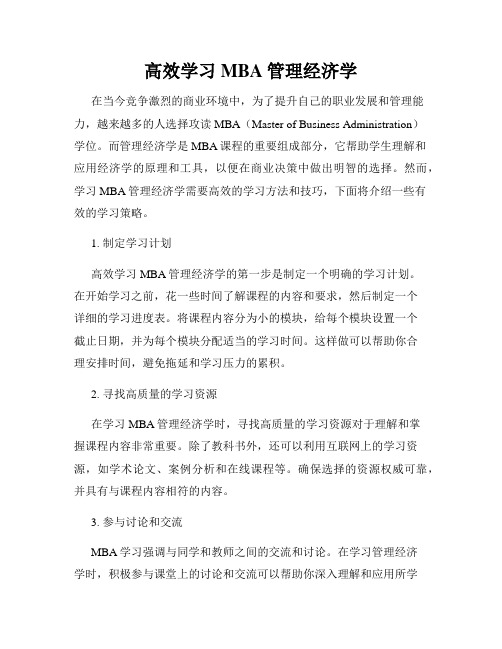
高效学习MBA管理经济学在当今竞争激烈的商业环境中,为了提升自己的职业发展和管理能力,越来越多的人选择攻读MBA(Master of Business Administration)学位。
而管理经济学是MBA课程的重要组成部分,它帮助学生理解和应用经济学的原理和工具,以便在商业决策中做出明智的选择。
然而,学习MBA管理经济学需要高效的学习方法和技巧,下面将介绍一些有效的学习策略。
1. 制定学习计划高效学习MBA管理经济学的第一步是制定一个明确的学习计划。
在开始学习之前,花一些时间了解课程的内容和要求,然后制定一个详细的学习进度表。
将课程内容分为小的模块,给每个模块设置一个截止日期,并为每个模块分配适当的学习时间。
这样做可以帮助你合理安排时间,避免拖延和学习压力的累积。
2. 寻找高质量的学习资源在学习MBA管理经济学时,寻找高质量的学习资源对于理解和掌握课程内容非常重要。
除了教科书外,还可以利用互联网上的学习资源,如学术论文、案例分析和在线课程等。
确保选择的资源权威可靠,并具有与课程内容相符的内容。
3. 参与讨论和交流MBA学习强调与同学和教师之间的交流和讨论。
在学习管理经济学时,积极参与课堂上的讨论和交流可以帮助你深入理解和应用所学的内容。
此外,加入学习小组或参加学术研讨会等活动也能提供更多的交流机会,拓宽自己的视野,加深对管理经济学的理解。
4. 多做练习和案例分析学习MBA管理经济学需要灵活运用经济学的原理和工具解决实际问题。
因此,多做练习和案例分析是提高学习效果的有效方法。
通过做练习题和实例分析,可以加深对理论知识的理解,培养分析问题和解决问题的能力。
5. 注重实践应用管理经济学的学习不仅仅是理论知识的纯粹掌握,更需要将其应用于实际情境中。
在学习过程中,将所学的经济学原理与实际商业问题相结合,思考如何应用所学的知识解决实际挑战。
例如,通过对市场供求关系的分析,预测和制定适当的价格策略。
6. 整理和复习知识点在学习过程中,及时整理和复习学到的知识点是巩固记忆和提高学习效果的重要环节。
MBA管理经济学:需求供给分析

衡价格和均衡数量都减少。
需求变动对均衡的影响(图示)
P
D3 D1
D2
S
P2 P1
P3
Q Q3 Q1 Q2
供给变动 对均衡价格和均衡数量的影响
在需求不变的情况下:
供给增加会使供给曲线向右平移,均 衡价格和均衡数量都减少。
供给减少会使供给曲线向左平移,均 衡价格和均衡数量都增加。
边际效用:消费者在一定时间内增 加最后一单位商品的消费时,所获 得的总效用量的增量。
某商品的效用表 λ=2
商品数量 总效用
边际效用 价格
0
0
1
10
10
5
2
18
8
4
3
24
6
3
4
28
4
2
5
30
2
1
6
30
0
0
7
28
-2
TU MU
TU Q
Q MU
边际效用递减规律
边际效用递减规律:随着某一种商 品的消费数量的不断增加,它所带 给消费者的效用增量是递减的。
第二节 供 给 分 析
一、供给函数
供给:一种商品的供给是指生产者在一定时 期内在各种可能的价格水平下,愿意而且能 够生产出的该商品的数量。
供给也分为单个供给和市场供给
影响供给的因素与供给函数
决定某种商品供给数量的因素
自身价格 生产成本 生产的技术水平 相关商品的价格 生产者对未来的预期
供给变动对均衡的影响(图示)
P
D
S3
S1
S2
P3
P1 P2
O
Q Q3 Q1 Q2
管理经济学mba试题及答案

管理经济学mba试题及答案管理经济学是MBA课程中的核心组成部分,它结合了经济学原理与商业实践,帮助学生理解市场机制、企业决策和政策制定。
以下是一套管理经济学的模拟试题及答案。
一、选择题(每题2分,共20分)1. 管理经济学的主要目标是什么?A. 降低成本B. 最大化利润C. 提高生产效率D. 增加市场份额答案:B2. 下列哪项不是完全竞争市场的特点?A. 产品同质化B. 买卖双方众多C. 无进入和退出障碍D. 单个买家或卖家对市场价格有显著影响答案:D3. 边际成本与平均成本的关系是什么?A. 边际成本总是高于平均成本B. 边际成本总是低于平均成本C. 边际成本与平均成本相等时,平均成本达到最低点D. 边际成本与平均成本没有直接关系答案:C4. 以下哪项不是垄断市场的特征?A. 单一卖家B. 高进入壁垒C. 产品差异化D. 价格由市场决定答案:D5. 什么是价格弹性?A. 价格变化对需求量的影响B. 价格变化对供应量的影响C. 需求量对价格变化的敏感度D. 供应量对价格变化的敏感度答案:A二、简答题(每题10分,共30分)1. 简述边际分析在企业决策中的应用。
答案:边际分析是管理经济学中的一种重要工具,它通过比较额外一单位产品的成本(边际成本)与额外收益(边际收益)来帮助企业做出最优决策。
企业在决定是否增加生产时,会考虑增加一单位产品所带来的额外成本是否小于额外收益。
如果边际收益大于边际成本,企业会增加生产;反之,则减少生产。
2. 解释什么是规模经济,并举例说明。
答案:规模经济是指当企业生产规模扩大时,单位产品的平均成本下降的现象。
这通常发生在固定成本在总成本中占比较大,而可变成本相对较小的情况下。
例如,汽车制造商在生产大量汽车时,可以分摊研发和工厂建设的固定成本,从而降低每辆车的平均成本。
3. 什么是市场失灵?请列举至少两个导致市场失灵的原因。
答案:市场失灵是指市场机制不能有效地分配资源,导致资源配置的效率低下。
管理经济学(MBA1)
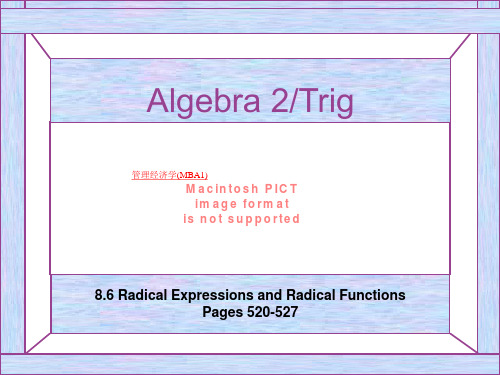
0
0.50
0
1.00
1
1.50
2
2.00
3
2.50
4
3.00
5
P 供给曲线
3.00 1.50 0.50
025
供给函数
Q = f(P) =2P-1
Q
供给量的变动和供给的变动
供给量的变动
P
沿供给曲线的变动
其它因素不变,
只是价格的变动
B
供给增加
6
4
A
C
供给减少
0
5
30 60 110
供给的变动 供给曲线的移动 其它因素改变, 价格可能也改变
经济学家
会计师
总收益
经济利润 隐性成本
显性成本
机会成本
会计利润 显性成本
19
基本分析方法:边际分析法
理性人考虑边际量
Marginal changes are small, incremental adjustments to an existing plan of action.
边际变动——对当前行动计划进行微小的增量调整。
基本概念:机会成本
基本方法:边际分析法
15
基本概念:机会成本
The opportunity cost of an item is what you give up to obtain that item. 机会成本——为了得到某种东西所
必需放弃的东西。
16
基本概念:机会成本和会计成本
机会成本:决策用;会计成本:报告用
10
市场经济:好的市场经济和坏的市场经济
坏的市场经济:权贵市场经济(前俄罗斯) 、寻租市场经济(前印度)
《MBA管理经济学》课件

在这个《MBA管理经济学》PPT课件中,我们将探讨管理经济学的定义、课程 目标和重要性,以及管理决策的经济原理。让我们一起来深入了解这门课程 的关键概念和案例分析。
课程介绍
定义
管理经济学的概念和作用
目标和重要性
掌握管理经济学对于管理决策的重要性
关键概念
1 经济学概念和框架
2 供求曲线和市场均衡
学习与管理决策密切相关的经济学概念和分析框 架
了解供求关系对市场均衡的影响
3 成本与产出分析
研究成本与产出之间的关系,为决策提供基础
4 竞争与垄断
探讨市场竞争和垄断对于经济影响的不同
劳动力市场和资本市场
劳动力市场
了解劳动力市场的特点和对管理决策的影响
资本市场
研究资本市场的运作和在管理决策中的作用
管理决策的经济原理
1
需求分析和定价策略
2
探索需求分析和定价策略对决策的影响
3
生产与效率
4
研究生产际效益
了解成本分析和边际效益在管理决策中的应 用
投资决策和风险管理
学习投资决策和风险管理的关键原则
案例分析
通过案例研究
应用管理经济学的知识和原理进行实际案例分析
管理经济学试题及答案mba
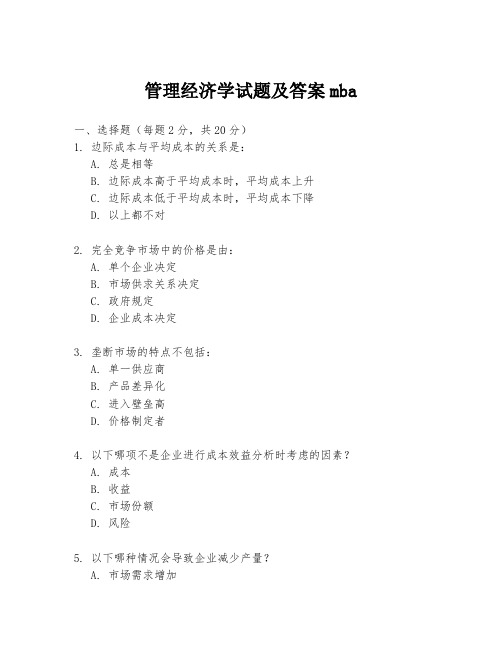
管理经济学试题及答案mba一、选择题(每题2分,共20分)1. 边际成本与平均成本的关系是:A. 总是相等B. 边际成本高于平均成本时,平均成本上升C. 边际成本低于平均成本时,平均成本下降D. 以上都不对2. 完全竞争市场中的价格是由:A. 单个企业决定B. 市场供求关系决定C. 政府规定D. 企业成本决定3. 垄断市场的特点不包括:A. 单一供应商B. 产品差异化C. 进入壁垒高D. 价格制定者4. 以下哪项不是企业进行成本效益分析时考虑的因素?A. 成本B. 收益C. 市场份额D. 风险5. 以下哪种情况会导致企业减少产量?A. 市场需求增加B. 固定成本增加C. 可变成本增加D. 产品价格上升二、简答题(每题10分,共30分)6. 简述规模经济的概念及其对企业的意义。
7. 解释什么是价格弹性,并举例说明。
8. 描述完全竞争市场和垄断市场的主要区别。
三、计算题(每题25分,共50分)9. 假设某企业生产函数为Q = 2L + 3K,其中Q是产量,L是劳动投入,K是资本投入。
如果企业的目标是最小化成本,且产品价格P = 100,劳动的边际成本w = 10,资本的边际成本r = 20,求企业最优的劳动和资本投入比例。
10. 某企业面临以下需求函数:P = 120 - 2Q,其中P是价格,Q是数量。
若企业的生产成本函数为C = 30 + 20Q。
求该企业的利润最大化产量和价格。
四、论述题(共30分)11. 论述企业在进行价格决策时需要考虑哪些因素,并给出一个具体行业的例子。
参考答案一、选择题1. B2. B3. B4. C5. C二、简答题6. 规模经济是指企业在生产规模扩大时,单位产品的平均成本下降的现象。
它对企业的意义在于,通过规模经济,企业可以降低成本,提高市场竞争力。
7. 价格弹性是指需求量对价格变化的敏感度。
如果价格弹性大于1,说明需求是弹性的;如果小于1,需求是无弹性的。
例如,奢侈品的需求通常具有较高的价格弹性。
MBA管理经济学

29 25.03.2020
2、弯折的需求曲线(斯威齐模型)
价格P P*
K
MC
AR MR O Q1 Q*Q2
产量Q
30 25.03.2020
3、寡头垄断市场的订价方法
寡头垄断市场上价格的决定也要区 分存在或不存在勾结。
在不存在勾结的情况下,价格决定的 方法是价格领先制和成本加成法;
亏损条件下的厂商短期均衡产量
5 25.03.2020
用边际成本和边际收益法分析的厂商短期均衡
厂商利润极大化的原则: 边际收益(MR)=边际成本(MC)
价格P
MC
AC
P
AR平均收益
MR边际收益
O Q*
产量Q
6 25.03.2020
厂商短期的供给曲线
价格P
MC边际成本 AC平均成本 AVC平均可变成本
市场存在不完善性。 各市场对同种产品的需求弹性不同。 可有效地将不同市场之间或市场的各部
份分开。
13 25.03.2020
垄断案例:广东打破电信垄断第一招—— 选号费将成历史
一个数字吉利的“靓号”公开炒卖到上 千甚至上万元,已不是新闻了,有的营业 柜台也公然收取所谓的“选号费”。在广 东首个电信条例正式出台之后,这些都将 成为历史。
例:石油输出国组织。
但由于卡特尔各成员之间的矛盾,有时达 成的协议也很难兑现,或引起卡特尔解体。
在不存在公开勾结的卡特尔的情况下,各 寡头还能通过暗中的勾结(又称默契)来确 定价格。
35 25.03.2020
4、博奕论
在寡头垄断市场,企业可以有两种策略选择:
不合作。即每个企业努力使自己的利润最大化;
MBA管理经济学
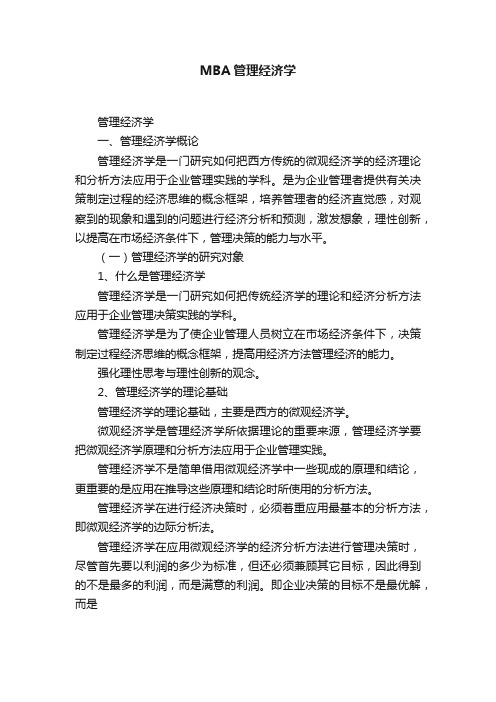
MBA管理经济学管理经济学一、管理经济学概论管理经济学是一门研究如何把西方传统的微观经济学的经济理论和分析方法应用于企业管理实践的学科。
是为企业管理者提供有关决策制定过程的经济思维的概念框架,培养管理者的经济直觉感,对观察到的现象和遇到的问题进行经济分析和预测,激发想象,理性创新,以提高在市场经济条件下,管理决策的能力与水平。
(一)管理经济学的研究对象1、什么是管理经济学管理经济学是一门研究如何把传统经济学的理论和经济分析方法应用于企业管理决策实践的学科。
管理经济学是为了使企业管理人员树立在市场经济条件下,决策制定过程经济思维的概念框架,提高用经济方法管理经济的能力。
强化理性思考与理性创新的观念。
2、管理经济学的理论基础管理经济学的理论基础,主要是西方的微观经济学。
微观经济学是管理经济学所依据理论的重要来源,管理经济学要把微观经济学原理和分析方法应用于企业管理实践。
管理经济学不是简单借用微观经济学中一些现成的原理和结论,更重要的是应用在推导这些原理和结论时所使用的分析方法。
管理经济学在进行经济决策时,必须着重应用最基本的分析方法,即微观经济学的边际分析法。
管理经济学在应用微观经济学的经济分析方法进行管理决策时,尽管首先要以利润的多少为标准,但还必须兼顾其它目标,因此得到的不是最多的利润,而是满意的利润。
即企业决策的目标不是最优解,而是满意解。
管理经济学在研究企业决策问题时,还要借用微观经济学以外的,其它理论与分析方法,如运筹学、市场学、统计学、会计学等等,以便收集、分析必要的信息,并在信息不确定的条件下,选择最优方案。
管理经济学是一门应用性学科,不能局限于对经济理论本身的探讨,要研究企业管理经济决策的实践,并把这些实践与经济学理论联系起来。
3、管理经济学的研究内容对管理经济学定义的描述及与微观经济学的对比分析中,我们可以看出管理经济学研究内容主要是依理决策,即据经济学之理论,进行企业管理中经济问题之决策,以寻求实现预定目标的最佳方案。
最新MBA-管理经济学-考试重点整理

《管理经济学》整理绪论P3管理经济学的对象和任务一、管理经济学的研究对象,以及与微观经济学之间的联系和区别:P3~P4 识记二、管理经济学的理论支柱及重要意义:P4~P6 识记三、管理经济学的决策准则对短期目标的设计和安排要服从于长期目标,在短期内,企业可以暂时放弃或减少对利润的追求。
1短期目标—是多样化的,它包括投资者、顾客、债权人、职工、政府、社会公众,以及技术改造。
领会P6企业价值的定义——是指企业未来预期利润收入的现值之和。
即:企业价值=∑=+nttti1)1(π=∑=+-nttttiTCTR1)1(式中πt是第t年的预期利润,i是资金利息率,t表示第几年(从第1年,即下一年到第n年即最后一年),由于利润等于总销售收入(TR)减去总成本(TC),式中TRt是企业在第t年的总销售收入,TCt是企业在第t年的总成本。
利润的种类及其在决策中的作用利润=销售收入-企业成本会计成本→不能用于决策,它属于历史成本;只反映使用企业资源的实际货币出,支未反映企业为使用这些P7 资源而付出的总代价。
机会成本——定义:是指资源用于其他的、次好的用途所可能得到的净收入。
它才是真正的成本。
几种特殊情况下的机会成本①业主用自己的资金办企业——把这笔资金借出可得到的利息。
P8 ②业主自己兼任经理——他在别处从事其他工作可得到的薪水。
③机器原来闲置,现在用来生产某种产品——零。
④机器原来生产A,可得利润X元,现在改生产B——生产A可得到的利润X元。
⑤过去买进的物料,现在市价变了,其机会成本——按市价计算。
⑥按目前市价购进的物料、雇用的职工以及贷入的资金——与其会计成本一致。
⑦机器设备折旧——该机器设备期初与期未可变卖价值之差。
是企业的实际收入>实际支出的部分,反映企业的盈亏状况。
.(不可用于决策)是指企业实际的支出,通常能在会计帐上表现出来。
企业利润-会计成本P7 成本和外显成本的差额。
识记+计算(外+内)简单应用销售收入-机会成本=销售收入-+计算意义——大于零,则说明资源用于本用途的价值要高于其他用途,资源配置较优,否则说明本用途的资源配置不合理。
MBA管理经济学

3
原材料
70
原材料
70
电力
3
工人工资
10
电力
3
工人工资
10
税务杂费
5
会计成本
94
会计利润
6
税务杂费
5
王先生夫妻放弃的工资
自有资金的利息
经济成本
102
经济利润
-2
5 3
显性成本:会计帐面上反映的实际支出 隐性成本:企业使用自己拥有的生产要素应该
支付的成本 会计利润和经济利润关系:
会计利润=企业收入-会计成本(显性成本) 经济利润=企业收入-会计成本-隐性成本
教学要求
在学习中注意培养三个观念 1 整合分析观念 2 比较分析观念 3 定量分析观念
单元一 管理经济学的有关概念及基
一、教学主题
本原理
1.管理经济学的内涵
2.企业的经营目标
3.会计利润与经济利润,显性成本与隐性成本
4.边际分析法和最优化原理
5.管理经济学的基本原理
二、阅读材料: 教材绪论
三、研讨题目:联系实际,谈谈在管理决策中运 用边际分析法的重要意义。
虚拟企业的高级形式:借脑,集智
案例:
耐克是生产什么的?
如果有人问你,耐克是生产什么的?答案是乎 很肯定:生产鞋的。但是你说错了,因为它是出售标 准和信息的,只不过这标准和信息是关于鞋的。
耐克总部不直接生产鞋,其生产线大部分转移 到了发展中国家,实行贴牌生产。但是,它有一个强 大的数据库,包括世界各地消费者的消费信息、产品 标准、质量标准、技术标准。耐克总部的核心工作是 对这些标准和信息进行管理、监控和研究。
管理经济学
课程性质
管理经济学是一门研究如何把微观经济学原 理和分析方法应用于企业管理决策实践的学 科。它是一门应用科学,是企业经营管理的 核心。
mba管理经济学考试题及答案
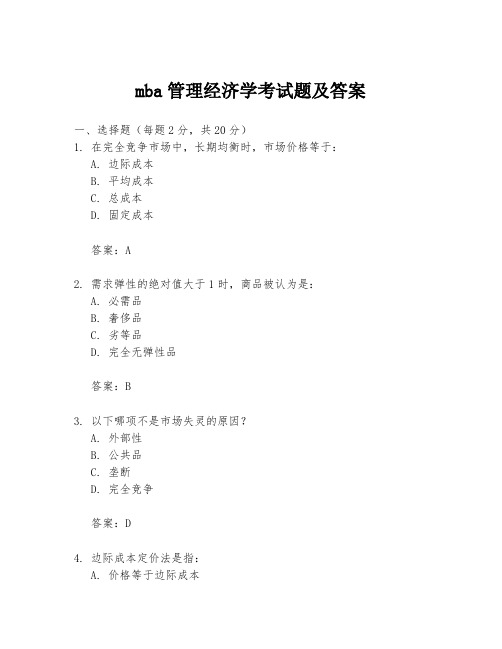
mba管理经济学考试题及答案一、选择题(每题2分,共20分)1. 在完全竞争市场中,长期均衡时,市场价格等于:A. 边际成本B. 平均成本C. 总成本D. 固定成本答案:A2. 需求弹性的绝对值大于1时,商品被认为是:A. 必需品B. 奢侈品C. 劣等品D. 完全无弹性品答案:B3. 以下哪项不是市场失灵的原因?A. 外部性B. 公共品C. 垄断D. 完全竞争答案:D4. 边际成本定价法是指:A. 价格等于边际成本B. 价格等于平均成本C. 价格等于总成本D. 价格等于固定成本答案:A5. 以下哪个是规模经济的来源?A. 技术进步B. 市场扩大C. 原材料成本下降D. 所有以上答案:D6. 价格歧视的第三度是:A. 个人歧视B. 地点歧视C. 时间歧视D. 产品歧视答案:D7. 以下哪个是完全垄断市场的特点?A. 只有一个卖者B. 产品同质性C. 存在许多买家D. 产品差异化答案:A8. 以下哪项不是企业进行成本控制的目的?A. 提高利润B. 降低成本C. 增加市场份额D. 提高生产效率答案:C9. 以下哪个是固定成本的例子?A. 原材料成本B. 租金C. 工资D. 能源费用答案:B10. 以下哪个是短期成本曲线?A. 平均总成本曲线B. 边际成本曲线C. 总成本曲线D. 固定成本曲线答案:B二、简答题(每题10分,共30分)1. 简述完全竞争市场的特点。
答案:完全竞争市场的特点包括市场上存在大量买家和卖家,产品同质性,自由进入和退出市场,完全信息,以及没有交易成本。
2. 解释什么是边际收益递减规律,并给出一个例子。
答案:边际收益递减规律指的是当持续增加一种生产要素,而其他要素保持不变时,新增加的生产要素所产生的额外产出(即边际产出)会逐渐减少。
例如,如果一个农场持续增加肥料的使用量,而土地面积和其他投入保持不变,那么肥料的边际产出会随着肥料量的增加而减少。
3. 什么是价格弹性?请解释其经济意义。
- 1、下载文档前请自行甄别文档内容的完整性,平台不提供额外的编辑、内容补充、找答案等附加服务。
- 2、"仅部分预览"的文档,不可在线预览部分如存在完整性等问题,可反馈申请退款(可完整预览的文档不适用该条件!)。
- 3、如文档侵犯您的权益,请联系客服反馈,我们会尽快为您处理(人工客服工作时间:9:00-18:30)。
~ Study of behavior of individual consumers, business firms, and markets
Business practices or tactics
~ Routine business decisions managers must make to earn the greatest profit under prevailing market conditions ~ Using marginal analysis, microeconomics provides the foundation for understanding everyday business decisions
1-10
Economic Cost of Using Resources
(Figure 1.2)
Explicit Costs
of Market-Supplied Resources The monetary payments to resource owners
+
Implicit Costs
of Owner-Supplied Resources The returns forgone by not taking the owners?resources to market
1-13
Maximizing the Value of a Firm
Maximize firm’s value by maximizing profit in each time period
~ Cost & revenue conditions must be independent across time periods
Market-supplied resources
~ Owned by others & hired, rented, or leased
Owner-supplied resources
~ Owned & used by the firm
1-8
Total Economic Cost
Total Economic Cost
~ An increase in the discount rate to compensate investors for uncertainty about future profits ~ The larger the risk, the higher the risk premium, & the lower the firm’s value
=
Total Economic Cost
The total opportunity costs of both kinds of resources
1-11
Economic Profit vs. Accounting Profit
Economic profit = Total revenue – Total economic cost = Total revenue – Explicit costs – Implicit costs Accounting profit = Total revenue – Explicit costs
~ Sum of opportunity costs of both marketsupplied resources & owner-supplied resources
Explicit Costs
~ Monetary opportunity costs of using marketsupplied resources
1-ห้องสมุดไป่ตู้2
Maximizing the Value of a Firm
Value of a firm
~ Price for which it can be sold ~ Equal to the present value of expected future profits
Risk premium
Moral Hazard
~ When either party to an agreement has incentive not to abide by all its provisions & one party cannot cost effectively monitor the agreement
Chapter 1 Managers, Profits, and Markets
McGraw-Hill/Irwin
Copyright © 2013 by The McGraw-Hill Companies, Inc. All rights reserved.
Learning Objectives
Understand why managerial economics relies on microeconomics and industrial organization to analyze business practices and design business strategies Explain the difference between economic and accounting profit and relate economic profit to the value of the firm Discuss problems arising from separation of ownership and control in businesses and suggest some corporate control mechanisms to address these problems Explain the difference between price-taking and pricesetting firms and discuss the characteristics of the four market structures
Separation of Ownership & Control
Principal-agent problem
~ Conflict that arises when goals of management (agent) do not match goals of owner (principal)
1-4
Microeconomics
Industrial organization
~ Specialized branch of microeconomics focusing on behavior & structure of firms & industries ~ Provides foundation for understanding strategic decisions through application of game theory
1-5
Strategic Decisions
Business actions taken to alter market conditions and behavior of rivals
~ Increase/protect strategic firm’s profit
While common business practices are necessary for the goal of profitmaximization, strategic decisions are generally optimal actions managers can take as circumstances permit
1-17
Price-Takers vs. Price-Setters
Price-taking firm
~ Cannot set price of its product ~ Price is determined strictly by market forces of demand & supply
Implicit Costs
~ Nonmonetary opportunity costs of using owner-supplied resources
1-9
Types of Implicit Costs
Opportunity cost of cash provided by owners
Economic theory helps managers understand real-world business problems
~ Uses simplifying assumptions to turn complexity into relative simplicity
1-3
Microeconomics
1-2
Managerial Economics & Theory
Managerial economics applies microeconomic theory to business problems
~ How to use economic analysis to make decisions to achieve firm’s goal of profit maximization
1-6
Economic Forces that Promote Long-Run Profitability (Figure 1.1)
1-7
Economic Cost of Resources
Opportunity cost is:
~ What firm owners must give up to use resources to produce goods & services
